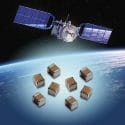source: AVX news
The new 200V ESCC QPL 3009 PME MLCCs provide critical PCB space savings & component weight reductions over stacked ceramic capacitors & performance improvements over 100V MIL-PRF capacitors in mil/aero applications including: space launchers, satellite communications, & power supplies
FOUNTAIN INN, S.C. (January 16, 2018) – AVX Corporation, a leading manufacturer and supplier of passive components and interconnect solutions, has extended its space-qualified ESCC QPL 3009 Series X7R multilayer ceramic surface-mount capacitors with new 200V PME MLCCs in 0805–2220 case sizes. Compact, lightweight, and currently available with capacitance values spanning 330pF – 330nF, the new 200V ESCC QPL 3009 PME MLCCs deliver significant performance improvements over 200V MIL-PRF stacked ceramic capacitors and 100V MIL-PRF surface mount products in 100V circuits when space derating rules are applied, providing engineers with effective, high-reliability solutions ideal for use in challenging space and military applications, including: space launchers, satellite communications, and the input/output filtering lines of space power supplies.
Tested to the European Space Components Coordination’s (ESCC’s) stringent 3009 standard, which is widely used in space projects the world over, the ESCC QPL 3009 PME Series now delivers high reliability performance in voltage ratings spanning 25–200V, capacitance values spanning 4.7pF to 2.2µF, and 0805–2220 cases with ESA Variant 03, 06, and 07 terminations, depending on the dielectric.
“Our new 200V ESCC QPL 3009 PME MLCCs provide space and military engineers with improved performance over both 200V MIL-PRF stacked ceramic and 100V surface mount capacitors before the 100V derating rules are applied, resulting in significant size and weight advantages,” said Michael Conway, product marketing manager, advanced ceramic products, AVX.
ESCC QPL 3009 PME MLCCs are available with standard lead times, and pricing is available upon request.































